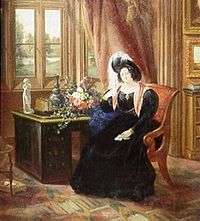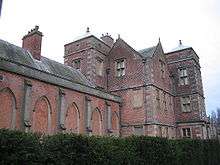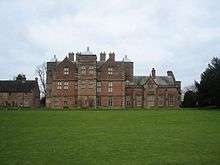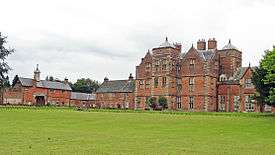Kiplin Hall
| Kiplin Hall | |
|---|---|
|
The west front of Kiplin Hall viewed from the lake | |
| Location | Kiplin, North Yorkshire, England |
| Coordinates | 54°22′20″N 1°34′45″W / 54.3721°N 1.5791°WCoordinates: 54°22′20″N 1°34′45″W / 54.3721°N 1.5791°W |
| Area | Vale of Mowbray |
| Built | 1622–1625 |
| Architectural style(s) | Jacobean architecture |
| Type | Cultural and arts |
| Criteria | i |
| Designated | 29 January 1953 |
| Reference no. | 1315476 |
| Country | England |
| Region | Europe and North America |
| Extensions | 1720s, 1820s |
Listed Building – Grade I | |
| Reference no. | 1226284[1] |
Kiplin Hall is a Jacobean historic house at Kiplin in North Yorkshire, England, and a Grade I listed building. It stands by the River Swale in the Vale of Mowbray. Kiplin Hall is rich in education, in architecture and art, a museum of history, a gallery and provides a biographical record of its past English country house owners.[2] The nearest villages are Scorton, Great Langton and Bolton-on-Swale.
Early settlement
Like many great estates, the history of Kiplin was shaped by the C16th religious conflicts around the Reformation. The land was originally a monastic holding, under the ownership of Easby Abbey. Following the dissolution of the monasteries, the land at Kiplin passed to John Scrope, 8th Baron Scrope of Bolton and then to Thomas Wharton, 2nd Baron Wharton.[3] Wharton, as a loyal servant of the Catholic Queen Mary, fell out of favour after her death, and sold the estate to the Calvert family in 1559.
Seventeenth century founding
The house was built sometime during 1622–1625 for George Calvert,[4] Secretary of State to James I, who later became first Lord Baltimore and founder of Maryland in what is now part of the United States.
Initially built as a hunting lodge it was a slightly rectangular building fashioned of red brick with diamond patterning known as diapering formed from blue-black headers incorporated into the brick bond. Kiplin had four towers, which unusually, were not placed at the corners of the structure, but at the centre of each of the four walls – the north and south towers containing staircases, whilst the east and west comprised part of the rooms in which they were contained. At the summit of each tower is an ogee dome.[2][4][5][6]
Eighteenth century
In 1722, Charles Calvert found himself in financial difficulties and sold the Kiplin estate to his mother's second husband (his stepfather) Christopher Crowe for £7,000 (£NaN as of 2016).[7][5] Although not a member of the nobility, Crowe had been British Consul in Livorno, Italy and enjoyed the lucrative contract for supplying the British naval fleet with wine and olive oil. Combined with his activities in collecting antiquities for the British aristocracy his wealth and power grew. Purchasing Kiplin Hall around a century after its construction, he found the house to lack comfort (the Calverts had never lived there) and set about a renovation programme including the addition of a grand staircase, fireplaces and dado rails as well as a servants' wing to the north (much of which was demolished in the 1970s). Crowe enlarged the Kiplin estate to some 4,000 acres.[8]

Nineteenth century
In 1817 Christopher Crowe's great-granddaughter Sarah Crowe married John Delaval Carpenter, fourth (and final) Earl of Tyrconnell of the fourth creation. The first Earl's daughter had been mistress to a Prince[9] and Almeria Carpenter's portrait by Angelica Kauffmann is displayed in the dining room.[10]
Lady Tyrconnell inherited Kiplin the following year and in 1819 commissioned the architect P. F. Robinson to build a wing to the south. Built in 'Wyatville's Gothic' this room was initially a Gothic-style drawing room. After 30 years of marriage the couple had one daughter, Elizabeth, who died the same day she was born. They were now faced with the problem of to whom they might pass the Hall and estate on their own deaths. Predeceased by her husband, in 1868 Sarah died leaving the estate to John Carpenter's first cousin twice removed, Captain Walter Cecil Talbot.[11]
Talbot was the second son of Henry John Chetwynd-Talbot, 18th Earl of Shrewsbury and inherited Kiplin Hall on condition that he legally changed his surname to Carpenter, married a Protestant and submitted to a seven yearly examination of his faith by a team of Anglican clergy. He accepted these conditions and inherited the estate in 1868, eventually taking up residence in 1887. He instructed the architect William Eden Nesfield to add a further floor to the Gothic-style drawing room and the space was converted to a Jacobean-style library. His second wife, Beatrice de Grey was prominent, in the Arts and Crafts movement and the Hall contains some beautiful works by local craftsmen in this style. Eventually promoted to Admiral, he died on a trip to London in 1904 and his only daughter Sarah Marie Talbot Carpenter inherited.[12]
Twentieth century
Sarah Talbot Carpenter married Christopher Hatton Turnor from Stoke Rochford in Lincolnshire in 1907 but they had no children. The couple never resided at Kiplin and the house was let to tenants. Five sales of land reduced the estate to 120 acres of land and disposed of many of the tenant farms, land and cottages which had contributed to its running. The estate entered virtually a century of decline. Much of the nearby local landscape has since been extensively quarried for sand and gravel extraction.[12]
In 1937, Sarah Turnor shared ownership of the Hall with her first cousin, Bridget Elizabeth Talbot, daughter of the Admiral's youngest brother Alfred. Miss Talbot had happy memories of visiting the estate in her childhood and had previously campaigned to save the Ashridge Estate near her home in Little Gaddesden (near Berkhamstead).[2] In an attempt to capitalise on the connection with Maryland (see above) she advertised the Hall as a guest house to American visitors and as a conference centre. From 1937 until 1958, she tried to interest the National Trust in taking over Kiplin, but they remained largely indifferent, considering the Hall of little historical significance and insisting that the north and south wings, which were later additions, would have to be demolished.[2][12]
In February 1968, Miss Talbot set up the Kiplin Hall Trust, its purpose being to hold Kiplin Hall and its appurtenances upon Trust permanently to preserve the same for the benefit of the nation as a place of beauty and historical and architectural interest. Bridget Talbot died in November 1971, leaving the contents of the Hall to the Trust, which still cares for the Hall and estate today.[2][12]
Bridget Talbot was a rather "remarkable woman who received the Italian Medal for Valour for her work with the Red Cross on the Italian-Austrian front during the First World War and who invented a waterproof torch for lifebelts which saved the lives of many seamen during the Second World War. She stood as a Liberal Party candidate for Bermondsey in 1950 and in 1968 established the Kiplin Charitable Trust to preserve the Hall."[6] Bridget Talbot was awarded for her service the Italian Medal of Military Valor (Medaglia d'oro al Valore Militare) for exceptional valour as a nurse, Croce di Guerra (Croce al Merito di Guerra) and the British Order of the British Empire as an Officer of the Most Excellent Order of the British Empire (O.B.E.).[12]
Twenty-first century
Following extensive renovation and refurbishment, the property is now open to the public and represents an insight into almost four centuries of life in North Yorkshire.[2][4]
A permanent exhibition charts the founding of Maryland by George Calvert and the lives of the families who have lived in Kiplin Hall through the centuries.[2][4]
Historic records of Kiplin Hall and its families from the early 18th century to the 21st century are held at the North Yorkshire County Record Office in Northallerton and at Kiplin Hall.[6]
Kiplin Hall provides programmes which support the National Curriculum Attainment Targets in art, art and design, patterns/materials/buildings, geography, history, physical education and science. Specific programmes include; Victorian Childhood, Portraits, Patterns and Materials, Nature Detectives, and the Second World War – How children lived (KS2 only).[13]
Collaborations
The University of Maryland, with funding from the state of Maryland, in 1986 opened the University of Maryland Study Center at Kiplin Hall, established a resource "built out of what was originally a stable house and blacksmith’s shop." It is open for students in the School of Architecture, Planning and Preservation.[14]
Washington College in Maryland offers a three-week summer program in English Literature. Lectures are presented each morning and students participate in afternoon field excursions. Significant historic, literary, landscape, and architectural sites of interest are part of field excursions. Influential literary figures such as Wordsworth, Coleridge, Shelley and others found the area around Kiplin Hall inspiring to their works.[15]
The University of South Carolina has a summer program (Hist 786) in England to "provide comparisons with U.S. theory and practice in archives administration, museum management, and historic preservation. It offers behind-the-scenes tours of museums and historic sites, as well as meetings with curators, archivists, administrators, and government officials to discuss the practice of public history in the UK." This includes Kiplin Hall.[16]
Ghost watch
In February 2007, the 17th-century Kiplin Hall started "torchlight ghost tours conducted by curator Dawn Webster and volunteer Mavis Palfreman." "Ghostly goings-on at the Hall are reported to include footsteps and sobbing in a drawing room, a Victorian woman seen on a staircase and a 1940s airman spotted in a kitchen. Many visitors and volunteers have also smelled pipe smoke in an old kitchen and a hint of cologne has been detected in another drawing room. Orbs have appeared in photos."[17]
Awards
Kiplin Hall received two Hudson's Heritage Awards in two categories "at a prestigious awards ceremony in London" on 3 December 2012. One was being chosen as England's "Hidden Gem" award and the other was for the "Best New Discovery."[18][19]
Images
 Front of the hall and main entrance |
 Front of the hall showing the later library extension |
 back of hall from lakeside |
References
- ↑ Historic England. "Kiplin Hall (1315476)". National Heritage List for England. Retrieved 29 August 2012. Listing National Grid Reference: SE 27446 97487
- 1 2 3 4 5 6 7 University of Maryland School of Architecture, Planning & Preservation (2012). "About Kiplin Hall". University of Maryland School of Architecture, Planning & Preservation. Retrieved 29 August 2012.
- ↑ "Kiplin Hall: The Families: The Calverts". Kiplin Hall. Retrieved 10 April 2016.
- 1 2 3 4 Kiplin Hall (2012). "The Builder and the Building". Kiplin Hall. Retrieved 29 August 2012.
- 1 2 Kiplin Hall (2012). "The Calverts – Kiplin in the 17th century". Kiplin Hall. Retrieved 29 August 2012.
- 1 2 3 The National Archives (2009). "Records of Kiplin Hall". The National Archives, Kew, Richmond, Surrey, England. Retrieved 29 August 2012.
- ↑ UK CPI inflation numbers based on data available from Gregory Clark (2016), "The Annual RPI and Average Earnings for Britain, 1209 to Present (New Series)" MeasuringWorth.
- ↑ Kiplin Hall (2012). "The Crowes – Kiplin in the 17th century". Kiplin Hall. Retrieved 29 August 2012.
- ↑ Charles Watkins; Ben Cowell (2012). Uvedale Price (1747-1829): Decoding the Picturesque. Boydell Press. pp. 36–37. ISBN 978-1-84383-708-4.
- ↑ Dining room, Kiplin Hall, Retrieved 9 July 2016
- ↑ Kiplin Hall (2012). "The Carpenters – Kiplin in the 17th century". Kiplin Hall. Retrieved 29 August 2012.
- 1 2 3 4 5 Kiplin Hall (2012). "The Talbots – Kiplin in the 17th century". Kiplin Hall. Retrieved 29 August 2012.
- ↑ Kiplin Hall (2012). "Schools". Kiplin Hall. Retrieved 29 August 2012.
- ↑ University of Maryland School of Architecture, Planning & Preservation (2010). "The University of Maryland Study Center at Kiplin Hall". University of Maryland School of Architecture, Planning & Preservation, College Park, Maryland. Retrieved 29 August 2012.
- ↑ Washington College (2012). "Kiplin Hall Program in English Literature". Washington College, 300 Washington Avenue, Chestertown, Maryland. Retrieved 29 August 2012.
- ↑ Grant, Haley (2012). "USC's England Field School". University of South Carolina. Retrieved 29 August 2012.
- ↑ Murdie, Alan (2008). "Yorkshire Ghost Busters". Strange Days: Ghostwatch. Fortean Times. Retrieved 29 August 2012.
- ↑ Grossman, Loyd (2012). "North Yorkshire attraction wins two national heritage awards". ITV.com. Retrieved 22 January 2013.
- ↑ "Hudson's Heritage Awards 2012 – This year's winners". Hudson Media, Ltd. 2012. Retrieved 22 January 2013.
External links
| Wikimedia Commons has media related to Kiplin Hall. |
- Official website
- Kiplin Hall restored to former glory – BBC news clip
- Historic England. "Details from image database (332063)". Images of England.
- Tag Archives: Kiplin Hall
- Kiplin Hall – Open Charities

